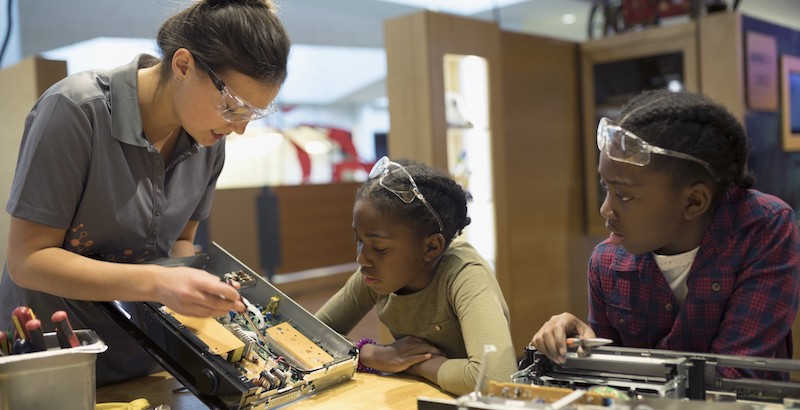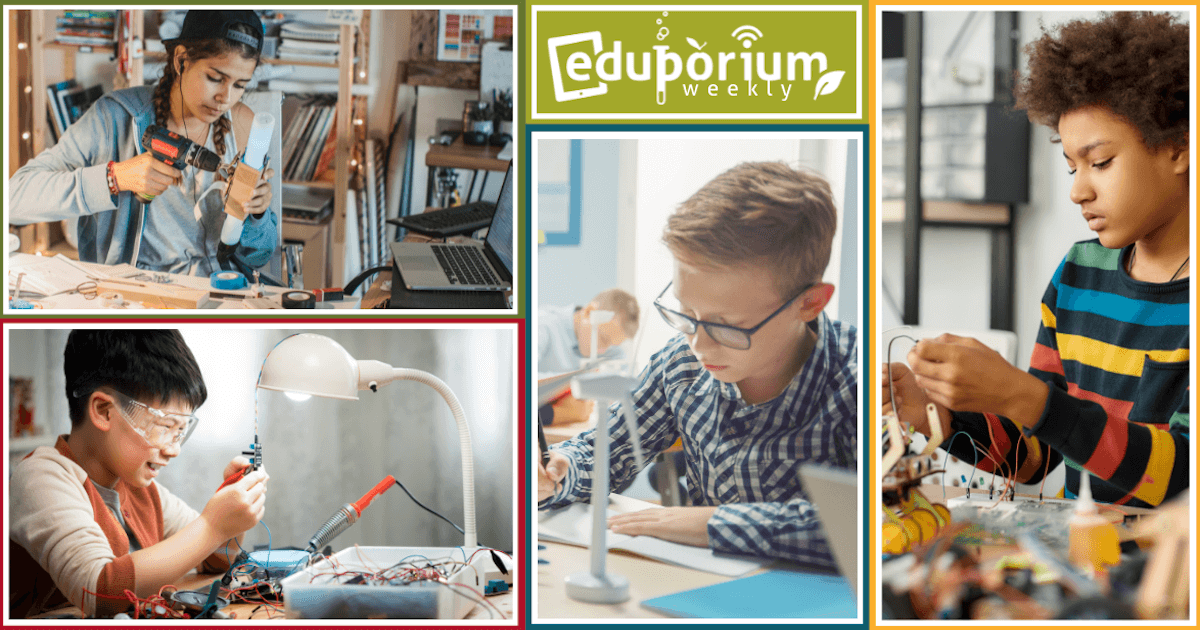There are, of course, many different pedagogical approaches that help educators lead effective instruction. Some of them are fond of promoting a growth mindset, a maker mindset, and maybe even a collaborative mindset. Whatever buzzwords we throw around, however, are only effective if their corresponding teaching techniques purposefully enhance the learning experience. What, then does it mean to involve and promote a STEM mindset? Well, this could mean a variety of things and ultimately help children start to think in new and beneficial ways. In today's classrooms, developing a STEM mindset can truly help them look at things from a new perspective.
What it Means to Have a STEM Mindset
Like we said, promoting a STEM mindset is super similar to promoting a growth mindset in your classroom. Over time, teachers can find success in helping students think like a STEM professional by modeling some of the best ways to go about that. Utilizing a STEM mindset might mean a lot of different things, however. It can also mean different things for different types of students. In a general sense, promoting the importance of a STEM mindset typically involves helping students see how their everyday classroom assignments and activities potentially connect to a future in STEM. Knowing more about how STEM professionals approach problems and discover solutions is a good starting point.
Combining the skills with the right mindset.
The mindset that students possess can affect their academic success in different ways. In the same way a growth mindset involves overcoming challenges, one of the key foundations of a STEM mindset is thinking a couple of steps ahead when problem solving. It also involves developing and applying both the hard and soft skills that drive success in the 21st century. Some of those skills, like innovation, inventiveness, and hands-on exploration, are certainly beneficial STEM skills. In STEM roles, professionals also need to have the ability to make informed decisions quickly, apply evidence to problem solving strategies, and employ strategic reasoning. And, all of these are competencies students can develop through STEM education.
Using STEM skills in life.
When teaching students the importance of developing a STEM mindset, educators might want to focus on helping them build life-related skills that they'll need for both the workforce and our society. The great thing with STEM skills, however, is that they aren't only useful for STEM careers. Truly fostering a STEM mindset helps students see that they're capable of solving the most complex science, technology, engineering, and math problems. It also involves asking the right questions to determine the most effective, evidence-based solutions. Then, students can apply this approach to strategically solving unique problems of their own on a local or global scale and in an ethical and creative way.
Modeling a STEM Mindset for Students
Students, especially the younger they are, can be very impressionable. It's super common for them to pick up on the tendencies, behaviors, and values their teachers model. Of course, educators can turn this into a positive, including in these efforts to model what it means to develop and implement a STEM mindset. One of the simplest ways to do this is with inquiry-based learning. Often, some of the best ways for students to make new discoveries is asking questions and challenging what they see. Like we said before, there's also the growth mindset factor. Students sometimes need to be pushed in order to hit their full potential, which comes into play in STEM learning. Without saying things the wrong way, educators can help students stay confident with the words they choose, but also indicate that they can always improve on their efforts.
How educators can model in the right way.
One of the best ways for teachers to model this is by employing a growth mindset themselves. This starts with taking a step back and reviewing how they deal with some challenges they face and how they react in front of students. It is important to have negative experiences and more important to learn the proper ways to react to them. Showing children that initial failure is just another opportunity that has been given to them can help them to learn the importance of working harder, trying new and creative approaches, and chasing improvement. Since failure is such a huge piece of STEM and hands-on learning, it should be no surprise that students will need the right mindset. And, seeing it modeled from their teachers should help as well.
The right kinds of inquiry and feedback.
Another way in which teachers can model a STEM mindset is through their feedback. Delivering feedback in a way that allows students to know their teachers recognize their hard work rather than their intelligence can motivate them to continue working hard. When teachers focus on new problem-solving processes and methods, they are more likely to use similar methods in the future. In STEM learning, that creative problem-solving process is often paramount. It also tends to be more important than the final result—similar to real STEM careers. Relying more on inquiry-based learning can even help get students thinking creatively and eliminate instances of them overlooking important information. And, teachers can certainly model what it takes to do this as well.

How to Help Students Develop a STEM Mindset
Those who believe in the power of a growth mindset believe their abilities can always be developed. This is no different when it comes to helping students develop a STEM mindset. STEM learning, naturally, involves a lot of trial and error. It could be easy for students to quickly become discouraged and feel like their efforts aren't working out. On the other hand, many students may already believe that they're not smart enough to enter a STEM field or profession. Kids form these perceptions at a very young age based on what they've heard in the media and around them. This is a classic example of a fixed mindset, and it should be easy to see why this belief won't get them very far—in the long run or even in classroom projects.
Demonstrating a STEM mindset to students.
Students know that they'll need a lot of intelligence, creativity, and dedication to succeed in the top STEM careers. The down side of that is they may think they don't have those skills based on how they view their natural abilities. In STEAM professions, however, we need a lot more than people who are book smart. We need people who are creative, who work well with others, and who aren't afraid to take risks. This is when having a STEM mindset—developed while in school—may truly help. Thinking in this way doesn't typically come naturally to young children, however. This means that educators often need to demonstrate positive thinking and learning from all experiences—even failures. When children better understand that learning is a lengthy process, they can look at problem solving from multiple angles, assess all options, and evaluate the best path forward.
From the classroom to the real world.
One of the best ways to model a STEM mindset for students is with real-world demonstrations. This gives educators the opportunity to preach the importance of understanding key concepts rather than just finding an answer or completing their assignment. It's also an opportunity to praise students for their work ethic or problem-solving strategies as we mentioned earlier. In real-world projects, students even have a chance to work on solving real-world problems. This allows them to see some authentic outcomes of their hard work and efforts in many cases. Knowing their work has a real-world connection can certainly inspire children to try new things, take risks, and utilize a STEM mindset as they explore new areas.
Building a STEM Mindset in the Classroom
Some of the things teachers can do to help students develop a STEM mindset are subtle. Others are more specific and may require targeted efforts. We should also keep in mind that some students may need more persistence from educators when it comes to giving STEM a chance. Young girls and students of color are often underrepresented in STEM—even in their childhood and teenage years. The right mindset, however, can help them feel more comfortable. Educators can even work with parents to suggest subtle strategies to help kids work on their STEM mindsets outside school. This helps reinforce what they're exposed to in the classroom and helps it start to come a bit more naturally.
Designing open-ended projects and embracing failure.
Teachers can set the tone for developing a STEM mindset with the nature of various projects they facilitate. With open-ended activities, students have the chances to get creative and arrive at more than one solution. This is a great opportunity for students to simultaneously develop their critical thinking and problem solving skills in STEAM endeavors. Also, helping students embrace failure is key in developing the proper mindset. When kids do ultimately succeed with their projects, educators can have them reflect on how they learned from initial failed attempts. This helps normalize not succeeding right away and allows children to embrace the struggle knowing a reward will follow.
Growing through self-assessment.
STEM experiences often involve long-term projects as opposed to assignments children complete in one class period. This presents them with the perfect opportunity to assess their efforts and attitudes. Often a component of social-emotional learning, self-assessment is a relevant aspect of STEM development as well. With help from their teachers, students can ask themselves questions that can help them bolster their STEM mindset. It starts with evaluating how they felt about how they approached their projects. This could help identify areas for improvement. It could also involve their attitudes and any discoveries throughout the learning process. Whether they reflect mostly on academic outcomes, collaboration, self-management, or something else, all of these can come together as they work on their STEM mindset.

How Kids Benefit from Building a STEM Mindset
Some students, parents, and instructors might naturally believe that STEM education is not necessary for everyone. It is also true that many students will go on to pursue a career outside of the STEM fields. Many, however, will wind up in a STEM profession and countless others will wind up teaching the next generation of students how to apply creativity and the proper mindset in solving tomorrow’s most complex challenges. The importance of STEM skills isn’t going anywhere and classroom experiences provide a foundation for building them. To start, STEM jobs make up such a big portion of our economy. That number continues to grow and vacancies remain high. When teachers remember this (they can also share it with their students), it can help affect their instruction and lead to students developing that STEM mindset.
Building the right mindset through the right experiences.
Since STEM is largely hands-on, students are able to learn some of the most valuable skills. With the right mindset, they should also start to see how these skills, which include critical thinking, assessment, design thinking, and various others will serve them very well. One thing about STEM experiences, however, is that developing STEM skills and a STEM mindset are also extremely helpful to those children who don’t pursue a STEM career. In STEM experiences, children are compelled to utilize logical thinking and to find a way to design unique solutions. Keeping this mindset intact for the long haul while drawing on these experiences can help students who wind up pursuing just about anything.
The right skills and mindset for managing projects.
Collaboration is also a huge part of the real world and, as a result, it’s part of developing a STEM mindset. Working with others provides various benefits and, if the students start to gravitate towards a team-centric approach in projects and problem solving, they can bolster that mindset even more. And, curricula focused on STEM experiences help kids develop another aspect of their STEM mindset: project management skills. STEM projects, as we have said, are often long-term endeavors. When working on these types of projects, children can learn the importance of managing time and deadlines and incorporate those experiences into how they think. In reality, the opportunities to develop a STEM mindset are everywhere. So, the more they work on bolstering theirs, the better off their prospects could be.
For the latest EdTech, STEM, and 21st century education news, follow us on Twitter and Instagram. Like us on Facebook, too, or sign up for our newsletter for our latest product announcements and offerings. If you have an idea for an Eduporium Weekly theme, send us a message on social media or comment below.



